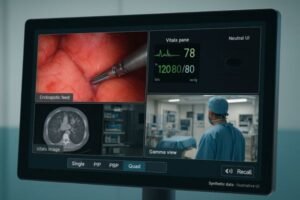Disasters strike without warning. Medical teams rush in, but fixed equipment can’t reach chaotic field sites. This delay can cost lives when rapid assessment is critical.
Portable monitors are vital for disaster response because they bring essential diagnostic imaging and patient monitoring capabilities directly to the point of care in unpredictable and resource-limited environments, enabling faster, life-saving decisions.
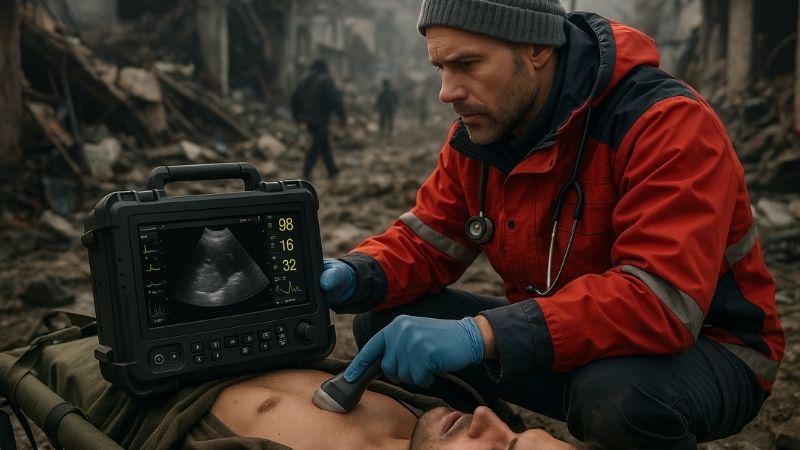
When a disaster hits, the ability to make quick, informed medical decisions on the ground is everything. I’ve always believed that technology should go where it’s needed most. Martin, our President at Reshin, built our company on advancing display technology1, initially for surgery, but the core principle of clear, reliable imaging2 applies everywhere. In disaster zones, the challenges are immense. Medical teams need tools that are not only powerful but also practical for the extreme conditions they face. Portable monitors are a key part of this toolkit. Let’s explore why these devices are so crucial for those brave units responding to emergencies.
How do portable monitors support real-time medical decision-making on-site?
In a crisis, seconds count. Waiting for hospital diagnostics isn’t an option. Field teams need immediate visual information to act decisively.
Portable monitors support real-time medical decision-making by providing immediate visual data from diagnostic tools like ultrasound or patient vitals directly at the incident site. This enables rapid assessment, triage, and initiation of treatment without delay.
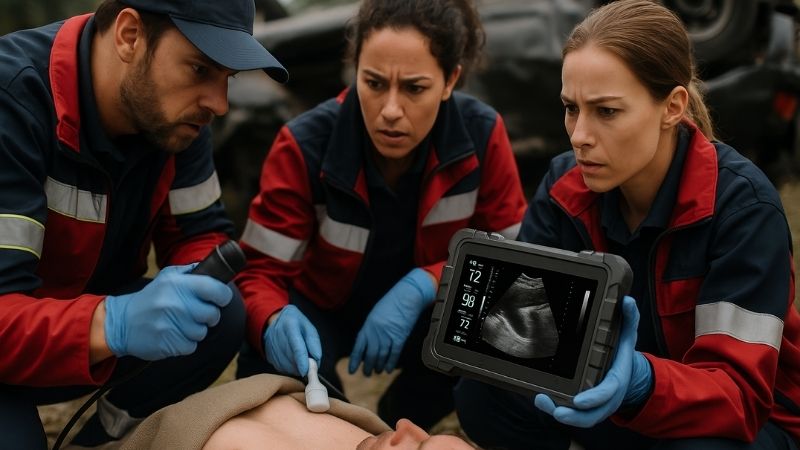
I think about the chaos of a disaster scene. Medical professionals are working against the clock, often with limited resources. One of my insights is that portable monitors3 are critical because they bring diagnostic capabilities directly to the field, dramatically reducing the delay between injury and initial assessment or treatment. Imagine a first responder using a portable ultrasound4 connected to a clear, portable display to check for internal bleeding right at an accident site. Or paramedics monitoring a patient’s vital signs on a bright screen while transporting them over rough terrain. This immediate visual information is invaluable. It allows for more accurate triage, helping teams prioritize the most critical patients. It can also guide initial life-saving procedures that simply cannot wait for transport to a hospital. At Reshin, we understand that the clarity and reliability of that display can directly influence the quality of these real-time decisions5. It’s about getting the right information to the right people, right when they need it most, to improve patient outcomes in the toughest situations. This ability to assess trauma or guide interventions directly at the point of care is a game-changer.
Why is rugged design essential in emergency environments?
Disaster zones are harsh. Equipment faces dust, water, drops, and shocks. Standard monitors would quickly fail, leaving teams without vital tools.
Rugged design is essential for portable monitors in emergency environments because these devices must withstand extreme temperatures, humidity, dust, water ingress, and physical impacts common in disaster zones to ensure reliable operation when critically needed.
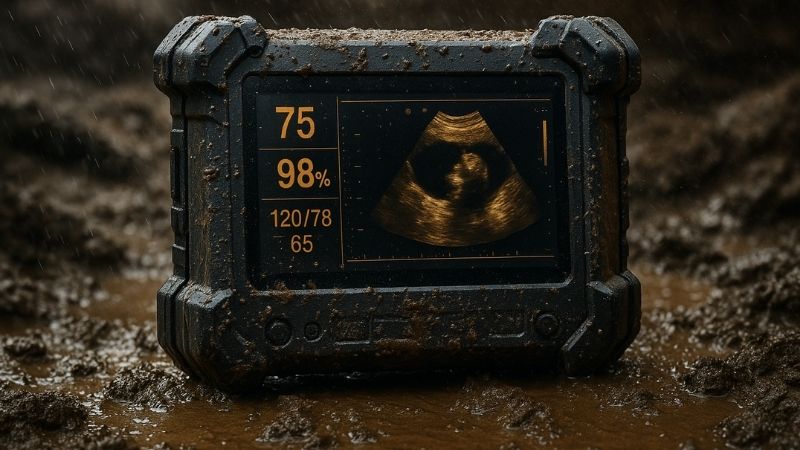
When we talk about emergency environments, we’re talking about places where standard electronics often don’t survive. I recall stories of equipment failing due to dust, unexpected rain, or being accidentally dropped during a hectic rescue. This is why a rugged design6 is not just a nice-to-have; it’s absolutely essential for portable monitors used by disaster response units. My insight is that unlike fixed monitors in a controlled hospital setting, these portable units must operate reliably under harsh environmental conditions. This includes extreme temperatures, both hot and cold, high humidity, and the constant threat of physical shock or vibration. A truly rugged monitor will have features like a sealed casing to protect against dust and water (often indicated by an IP rating7), shock-absorbent construction, and durable screen materials. Martin often emphasizes that reliability is paramount in medical devices. If a monitor fails in the middle of a critical assessment in the field, the consequences can be severe. Therefore, at Reshin, even when considering designs for challenging environments, we focus on durability and resilience8, ensuring our displays can perform when they are needed most, no matter the conditions. The ability to trust your equipment in a crisis is fundamental for these response teams.
Here’s a look at typical environmental challenges and how rugged design addresses them:
| Environmental Challenge | Impact on Standard Monitors | Rugged Design Feature | Benefit in Disaster Zones |
|---|---|---|---|
| Dust and Dirt | Clogs vents, damages components | Sealed casing (IP rated) | Prevents internal contamination |
| Water/Liquids | Short circuits, corrosion | Water-resistant/proof casing (IP rated) | Operates in rain, spills |
| Drops and Shocks | Screen cracks, internal damage | Shock-absorbent materials, robust frame | Survives accidental impacts |
| Extreme Temperatures | Component failure, screen issues | Extended operating temperature range | Reliable in hot/cold climates |
| Vibration | Loose connections, damage | Reinforced internal components | Withstands transport over rough terrain |
Can portable monitors integrate with diverse diagnostic devices in the field?
Field diagnostics use various tools. From ultrasound to endoscopes. A portable monitor must connect easily to provide a clear view for all.
Yes, portable monitors can and must integrate with diverse diagnostic devices in the field. They are often designed with multiple input ports (e.g., HDMI, SDI, USB-C) to connect to ultrasound probes, portable X-ray systems, vital signs sensors, and endoscopes, ensuring versatility.
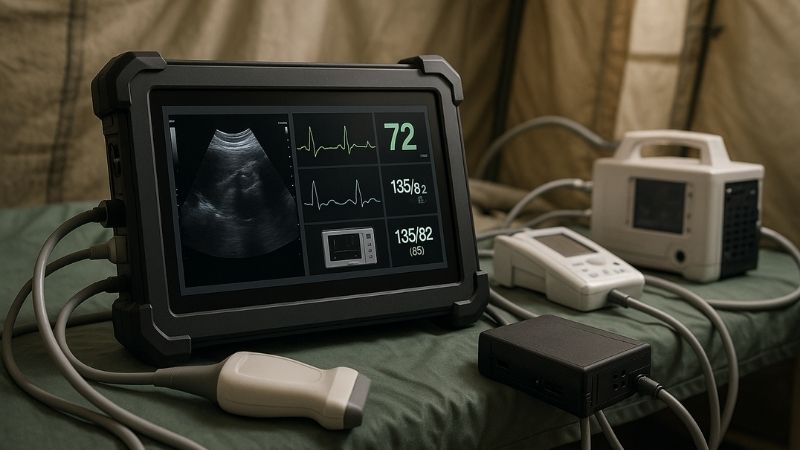
In a disaster response situation, medical teams might deploy a range of diagnostic tools9 depending on the scenario. They could have portable ultrasound units, perhaps a compact digital X-ray system, or even simple vital signs sensors. A key challenge is ensuring that the visual output from these different devices can be easily displayed. My insight is that a truly useful portable monitor10 must be versatile in its connectivity. It needs to be able to plug and play with a variety of equipment from different manufacturers. This means having standard input options like HDMI, and increasingly, USB-C for both signal and sometimes power. For more specialized medical imaging, inputs like SDI might also be necessary. The monitor’s internal processing should also be capable of handling different signal types and resolutions effectively. At Reshin, while our primary focus has been on surgical and diagnostic displays for hospitals, the underlying principle of interoperability11 is something Martin has always stressed. For a disaster unit, having a single, reliable portable display that can connect to whatever diagnostic tool is available on-site simplifies their workflow, reduces the amount of gear they need to carry, and ensures they can get a clear image quickly. This adaptability is crucial when you don’t know exactly what challenges or equipment you’ll encounter.
How do size and weight affect deployment efficiency?
Every second matters in a disaster. Bulky, heavy gear slows teams down. Portable monitors must be genuinely easy to move and set up quickly.
Size and weight critically affect deployment efficiency. Lighter, more compact portable monitors are easier and faster to transport, set up, and relocate in dynamic disaster situations, allowing medical teams to be more agile and responsive.
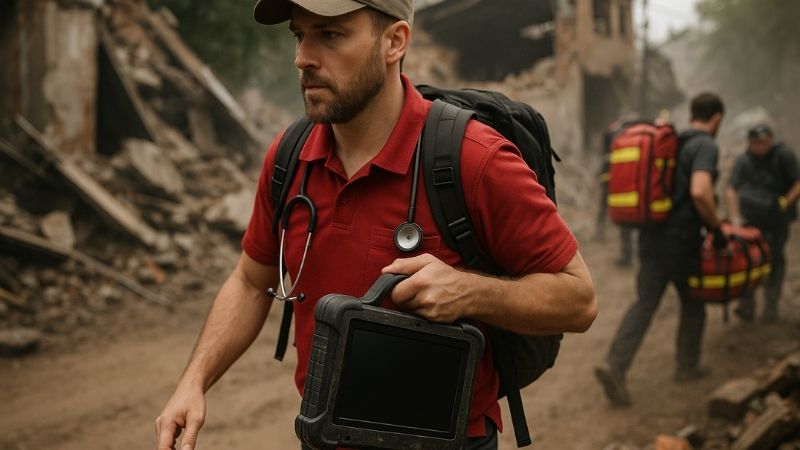
When I think about the logistics of a disaster response, efficiency of movement is paramount. Teams often have to carry all their equipment over difficult terrain or into cramped spaces. This is where the "portable" aspect of portable monitors12 becomes truly critical. My insight is that from an operational standpoint, portability, meaning manageable size and low weight, directly enhances logistical agility13. If a monitor is too big or too heavy, it becomes a burden rather than an asset. It might get left behind, or it might slow the team down, costing precious time. A truly portable monitor, perhaps something like a 21-inch or even a well-designed 27-inch model if it’s exceptionally lightweight for its class, can be packed quickly, carried by a single person if necessary, and set up in moments. This allows medical teams to establish a diagnostic or monitoring station rapidly wherever it’s needed most, and then just as quickly pack up and relocate as the situation evolves or new priorities emerge. At Reshin, we’re always looking at how to make displays more efficient, and in a disaster context, physical efficiency14 – size and weight – is just as important as image quality. The goal is to provide powerful imaging without hindering the team’s ability to respond swiftly.
What power and connectivity features are critical in disaster zones?
Power grids fail in disasters. Networks go down. Portable monitors need to keep working, relying on their own power and versatile connections.
Critical power features for portable monitors in disaster zones include long-lasting internal batteries, compatibility with external battery packs or vehicle power, and low power consumption. Essential connectivity includes robust physical ports and ideally, options for wireless display if secure networks are available.
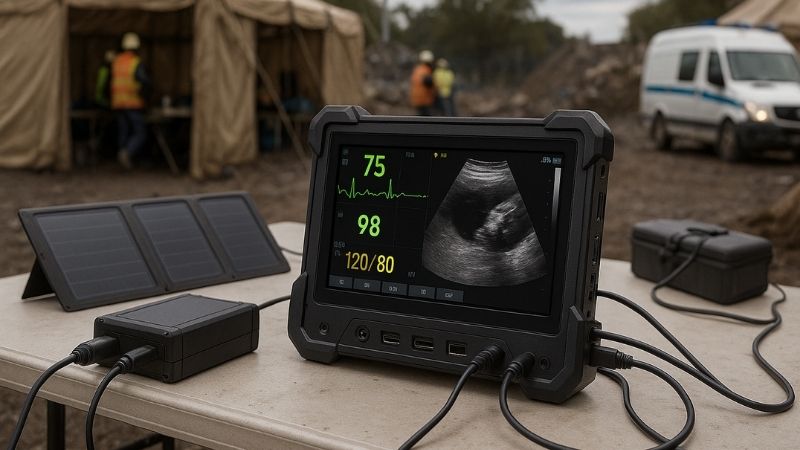
One of the first things to go in many disaster scenarios is the power grid. And stable communication networks? Often non-existent or overloaded. So, for a portable monitor to be truly effective in these conditions, its power and connectivity features are absolutely critical. My insight is that these units are often battery-powered15 or designed to be compatible with common mobile power sources, making them suitable for locations without any stable electricity. An ideal portable monitor16 for disaster response would have a built-in battery with a decent operational life, say several hours at least. It should also have the flexibility to be powered or recharged from various sources – like external battery banks (power bricks), vehicle DC power outlets, or even small solar chargers if the situation allows. Low power consumption is also a key design goal to maximize operating time. For connectivity, while robust physical ports like HDMI, USB, and SDI are the most reliable for direct device connection, some thought must be given to data transfer or even wireless display capabilities if a secure, ad-hoc local network can be established. However, in many disaster scenarios, wired connections remain the most dependable. At Reshin, we understand that a device is only useful if it can be powered on and connected when and where it’s needed, especially when lives are on the line.
Key features for power and connectivity:
| Feature Category | Essential Aspects for Disaster Zones | Benefit |
|---|---|---|
| Power | Long-life internal battery | Extended operation without external power |
| Support for external battery packs / vehicle power (DC input) | Flexible recharging/powering options | |
| Low power consumption design | Maximizes operational time on battery | |
| Clear battery status indicator | Allows for timely recharging or power source switching | |
| Connectivity | Multiple robust physical input ports (HDMI, USB, SDI) | Compatibility with diverse field diagnostic equipment |
| Secure and durable connector types | Reliable connections in unstable environments | |
| Simple, quick connection process (plug-and-play) | Rapid setup, minimizing delays | |
| (Optional) Secure wireless display capability for specific scenarios | Reduces cable clutter if a stable local network can be established |
Conclusion
Portable monitors are indispensable in disaster response, delivering vital imaging to the field, enhancing decision-making, and ultimately improving patient outcomes in critical situations.
Learn how Reshin’s portable solutions can support emergency care—contact us at martin@reshinmonitors.com.
-
Discover the latest advancements in display technology that are transforming medical practices, especially in crisis situations. ↩
-
Understanding the significance of clear imaging can improve emergency medical responses and save lives. ↩
-
Explore how portable monitors enhance medical response in disaster situations, improving patient outcomes and decision-making. ↩
-
Learn about the impact of portable ultrasound technology in emergency care, especially in critical situations like accidents. ↩
-
Discover the importance of real-time decision-making in emergencies and how it affects patient care and outcomes. ↩
-
Explore how rugged design enhances the reliability and performance of portable monitors in critical situations, ensuring they withstand harsh conditions. ↩
-
Understanding IP ratings can help you choose the right equipment that is protected against dust and water, crucial for emergency response. ↩
-
Learn why durability and resilience are key factors in medical devices, especially in high-stakes environments like disaster response. ↩
-
Learn about essential diagnostic tools that can significantly improve medical response in disaster situations, ensuring better patient outcomes. ↩
-
Explore this link to discover top portable monitors designed for medical applications, ensuring versatility and reliability in disaster response. ↩
-
Understanding interoperability in medical devices can enhance your knowledge of efficient disaster response and patient care. ↩
-
Explore how portable monitors enhance efficiency and agility in disaster response, crucial for saving time and lives. ↩
-
Understanding logistical agility can help improve disaster response strategies and ensure timely aid delivery. ↩
-
Learn why size and weight matter in disaster response equipment to optimize performance and mobility. ↩
-
Learn about the advantages of battery-powered devices in emergencies, ensuring reliability and functionality when traditional power sources fail. ↩
-
Explore this link to discover top-rated portable monitors designed for emergency situations, ensuring you stay connected when it matters most. ↩

